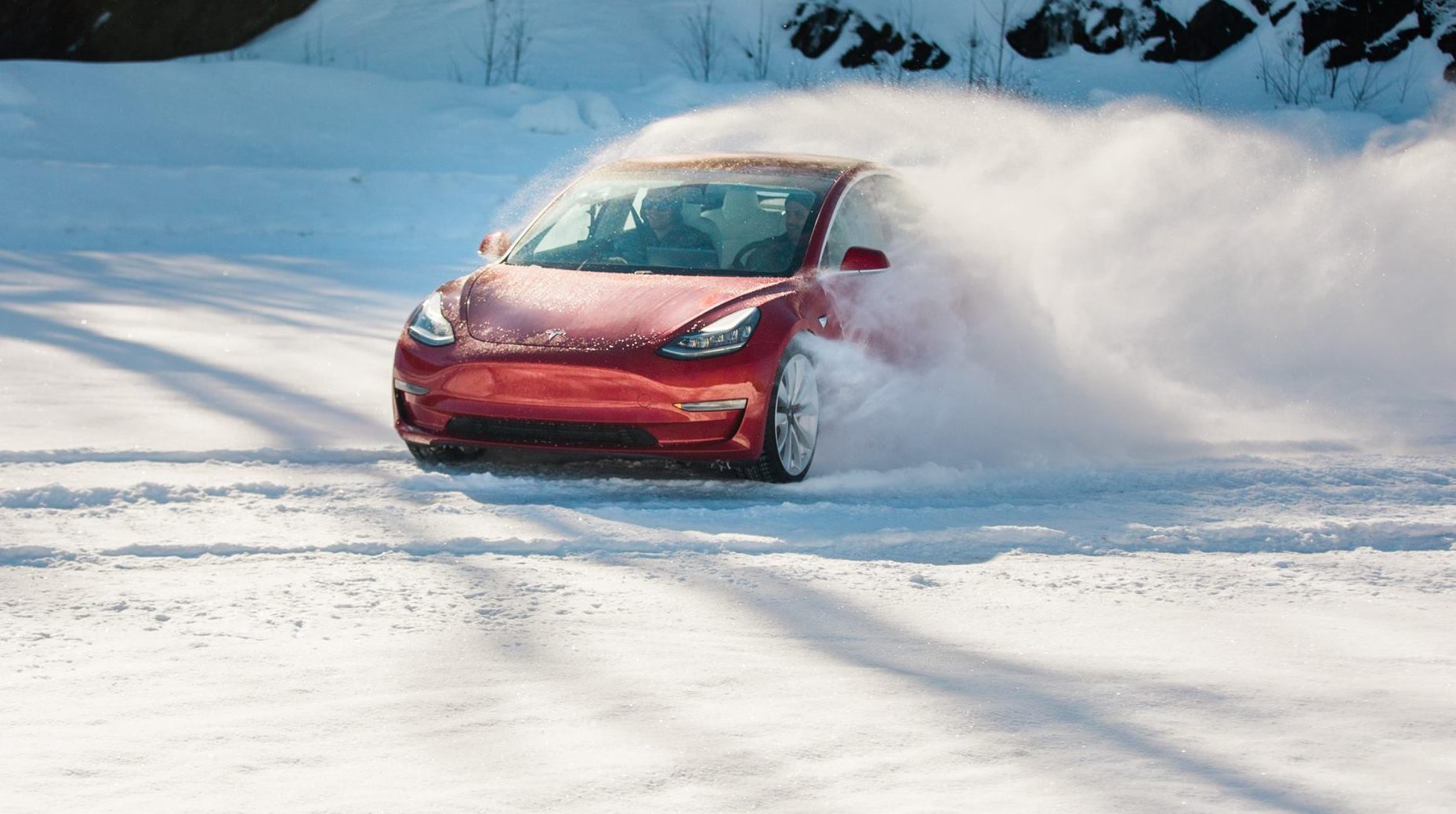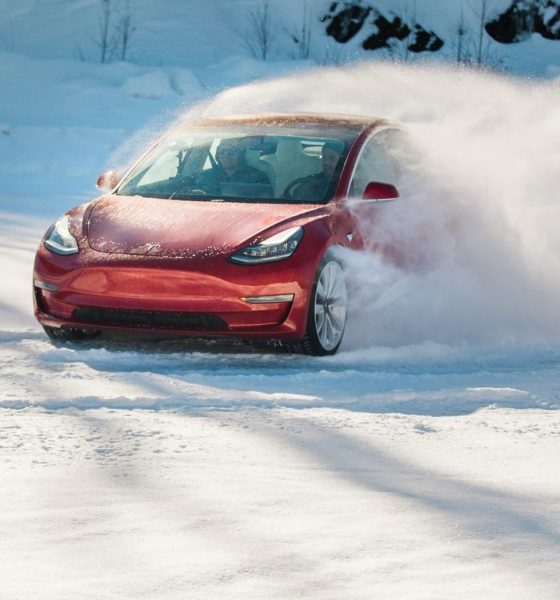

Investor's Corner
The Tesla Model 3 is rocketing past Europe’s best-selling electric cars: analyst
The Tesla Model 3 achieved yet another milestone as it continues its international ramp. Over the first quarter, the electric sedan from Silicon Valley successfully rocketed past other popular electric cars in Western Europe, taking its place at the top of the region’s list of best-selling EVs.
Berlin-based automotive industry analyst Matthias Schmidt noted that Tesla sold 19,482 Model 3 in the first quarter, a significant lead over the previous #1 EV in the region, the ubiquitous Renault Zoe, which sold 11,049 units over the same period. This is particularly impressive for the Model 3, as it was only available in the market since February, and it was more than twice, or (at times) even three times the cost of the best-selling Zoe. The Nissan Leaf, a veteran in the mainstream EV market, bowed down to the Model 3 as well, selling 10,315 in the first quarter.
The Model 3’s competitors in the premium electric vehicle segment were farther off. The Jaguar I-PACE, which recently received the World Car of the Year award, was 7th place in Europe’s sales, selling 3,012 units in Q1. The Audi e-tron, also a much-hyped vehicle that was, at one time, considered as a potential “Tesla Killer” by skeptics, sold a rather humble 2,526 units in the first quarter, according to the Berlin-based analyst’s data.
In a statement to Forbes, the auto analyst noted that the Model 3’s competition from Europe might be deliberately holding back their sales due to the European Union’s (EU) carbon dioxide (CO2) regulations, which are set to become tighter next year. According to Schmidt, automakers might be aiming to grow their electric car fleets in 2021, in order to bring down their average emissions and avoid fines. Thus, Tesla has all the opportunity it needs to push the Model 3 today, since its all-electric fleet is in no danger from the EU’s tightening emissions rules.
“I expect the Model 3 to finish the year as the top-selling electric car model in Europe helped along by the fact that other manufacturers are reducing supply of their electric models to 2020, with plenty of creative excuses, in order to lower their fleet average CO2 emissions – when it counts – to achieve the next round of EU targets being introduced in 2020 covering 95% of their total fleet and 100% in the following year. Tesla is the only manufacturer that doesn’t have an issue meeting fleet average CO2 emissions and effectively has an open goal up to the end of this year,” the analyst said.
The Tesla Model 3 is proving to be a disruptive vehicle in every region it has been deployed to so far. With Model 3 deliveries focused on North America last year, the electric sedan became the best-selling luxury vehicle in the United States. The Model 3 made its presence known as it made its way into Europe as well. Norway, for one, reported that nearly 60% of all vehicles sold in the country in March were all-electric. More than 18,000 cars were registered in the country during the month, and over 10,000 were all-electric. From this number, 5,822 were Tesla Model S, Model 3, and Model X, which means that one in every three vehicles sold in Norway in March was a Tesla. The Model 3 also made a strong impact in Switzerland, where the all-electric car became the country’s best-selling car at the end of Q1, electric or otherwise.

Investor's Corner
Tesla stock closes at all-time high on heels of Robotaxi progress

Tesla stock (NASDAQ: TSLA) closed at an all-time high on Tuesday, jumping over 3 percent during the day and finishing at $489.88.
The price beats the previous record close, which was $479.86.
Shares have had a crazy year, dipping more than 40 percent from the start of the year. The stock then started to recover once again around late April, when its price started to climb back up from the low $200 level.
This week, Tesla started to climb toward its highest levels ever, as it was revealed on Sunday that the company was testing driverless Robotaxis in Austin. The spike in value pushed the company’s valuation to $1.63 trillion.
Tesla Robotaxi goes driverless as Musk confirms Safety Monitor removal testing
It is the seventh-most valuable company on the market currently, trailing Nvidia, Apple, Alphabet (Google), Microsoft, Amazon, and Meta.
Shares closed up $14.57 today, up over 3 percent.
The stock has gone through a lot this year, as previously mentioned. Shares tumbled in Q1 due to CEO Elon Musk’s involvement with the Department of Government Efficiency (DOGE), which pulled his attention away from his companies and left a major overhang on their valuations.
However, things started to rebound halfway through the year, and as the government started to phase out the $7,500 tax credit, demand spiked as consumers tried to take advantage of it.
Q3 deliveries were the highest in company history, and Tesla responded to the loss of the tax credit with the launch of the Model 3 and Model Y Standard.
Additionally, analysts have announced high expectations this week for the company on Wall Street as Robotaxi continues to be the focus. With autonomy within Tesla’s sights, things are moving in the direction of Robotaxi being a major catalyst for growth on the Street in the coming year.
Elon Musk
Tesla needs to come through on this one Robotaxi metric, analyst says
“We think the key focus from here will be how fast Tesla can scale driverless operations (including if Tesla’s approach to software/hardware allows it to scale significantly faster than competitors, as the company has argued), and on profitability.”

Tesla needs to come through on this one Robotaxi metric, Mark Delaney of Goldman Sachs says.
Tesla is in the process of rolling out its Robotaxi platform to areas outside of Austin and the California Bay Area. It has plans to launch in five additional cities, including Houston, Dallas, Miami, Las Vegas, and Phoenix.
However, the company’s expansion is not what the focus needs to be, according to Delaney. It’s the speed of deployment.
The analyst said:
“We think the key focus from here will be how fast Tesla can scale driverless operations (including if Tesla’s approach to software/hardware allows it to scale significantly faster than competitors, as the company has argued), and on profitability.”
Profitability will come as the Robotaxi fleet expands. Making that money will be dependent on when Tesla can initiate rides in more areas, giving more customers access to the program.
There are some additional things that the company needs to make happen ahead of the major Robotaxi expansion, one of those things is launching driverless rides in Austin, the first city in which it launched the program.
This week, Tesla started testing driverless Robotaxi rides in Austin, as two different Model Y units were spotted with no occupants, a huge step in the company’s plans for the ride-sharing platform.
Tesla Robotaxi goes driverless as Musk confirms Safety Monitor removal testing
CEO Elon Musk has been hoping to remove Safety Monitors from Robotaxis in Austin for several months, first mentioning the plan to have them out by the end of 2025 in September. He confirmed on Sunday that Tesla had officially removed vehicle occupants and started testing truly unsupervised rides.
Although Safety Monitors in Austin have been sitting in the passenger’s seat, they have still had the ability to override things in case of an emergency. After all, the ultimate goal was safety and avoiding any accidents or injuries.
Goldman Sachs reiterated its ‘Neutral’ rating and its $400 price target. Delaney said, “Tesla is making progress with its autonomous technology,” and recent developments make it evident that this is true.
Investor's Corner
Tesla gets bold Robotaxi prediction from Wall Street firm
Last week, Andrew Percoco took over Tesla analysis for Morgan Stanley from Adam Jonas, who covered the stock for years. Percoco seems to be less optimistic and bullish on Tesla shares, while still being fair and balanced in his analysis.

Tesla (NASDAQ: TSLA) received a bold Robotaxi prediction from Morgan Stanley, which anticipates a dramatic increase in the size of the company’s autonomous ride-hailing suite in the coming years.
Last week, Andrew Percoco took over Tesla analysis for Morgan Stanley from Adam Jonas, who covered the stock for years. Percoco seems to be less optimistic and bullish on Tesla shares, while still being fair and balanced in his analysis.
Percoco dug into the Robotaxi fleet and its expansion in the coming years in his latest note, released on Tuesday. The firm expects Tesla to increase the Robotaxi fleet size to 1,000 vehicles in 2026. However, that’s small-scale compared to what they expect from Tesla in a decade.
Tesla expands Robotaxi app access once again, this time on a global scale
By 2035, Morgan Stanley believes there will be one million Robotaxis on the road across multiple cities, a major jump and a considerable fleet size. We assume this means the fleet of vehicles Tesla will operate internally, and not including passenger-owned vehicles that could be added through software updates.
He also listed three specific catalysts that investors should pay attention to, as these will represent the company being on track to achieve its Robotaxi dreams:
- Opening Robotaxi to the public without a Safety Monitor. Timing is unclear, but it appears that Tesla is getting closer by the day.
- Improvement in safety metrics without the Safety Monitor. Tesla’s ability to improve its safety metrics as it scales miles driven without the Safety Monitor is imperative as it looks to scale in new states and cities in 2026.
- Cybercab start of production, targeted for April 2026. Tesla’s Cybercab is a purpose-built vehicle (no steering wheel or pedals, only two seats) that is expected to be produced through its state-of-the-art unboxed manufacturing process, offering further cost reductions and thus accelerating adoption over time.
Robotaxi stands to be one of Tesla’s most significant revenue contributors, especially as the company plans to continue expanding its ride-hailing service across the world in the coming years.
Its current deployment strategy is controlled and conservative to avoid any drastic and potentially program-ruining incidents.
So far, the program, which is active in Austin and the California Bay Area, has been widely successful.








